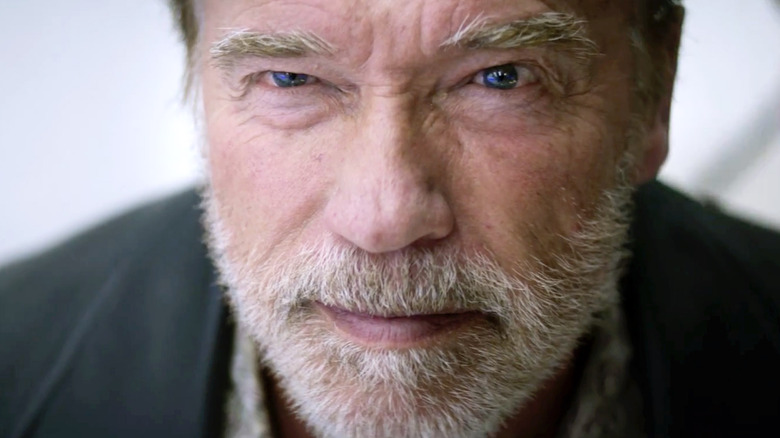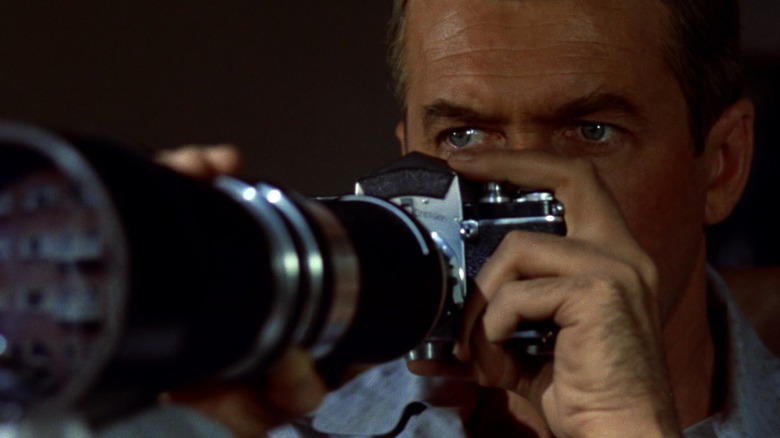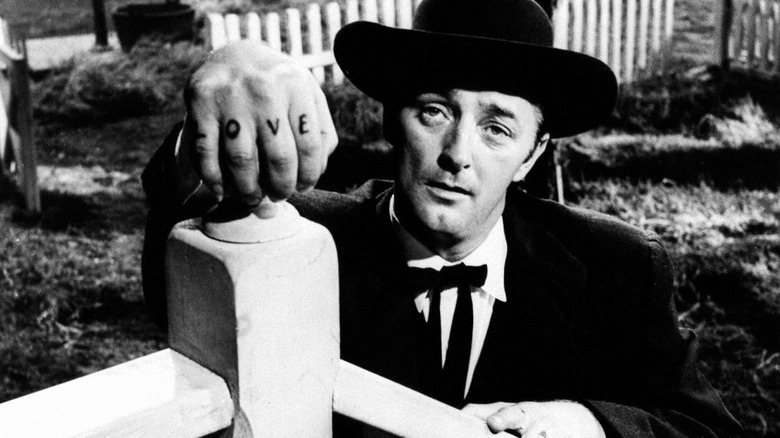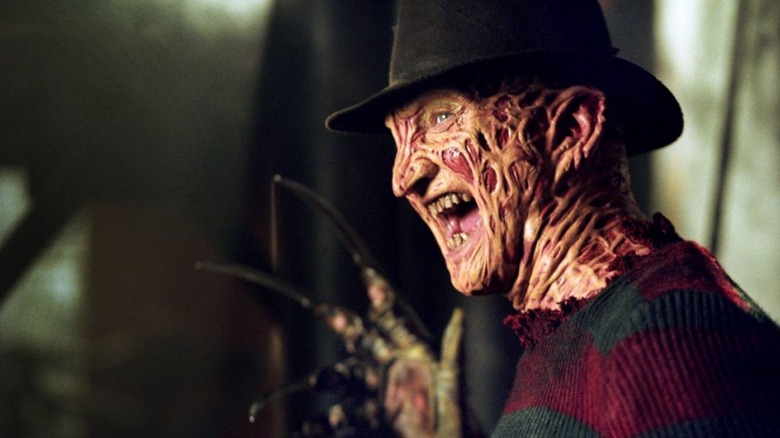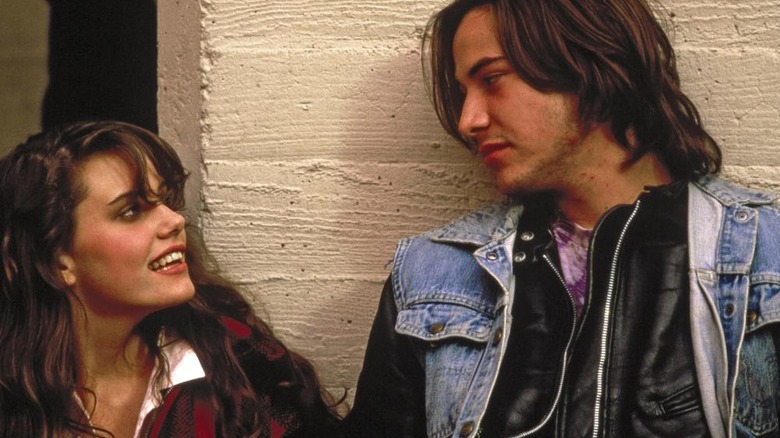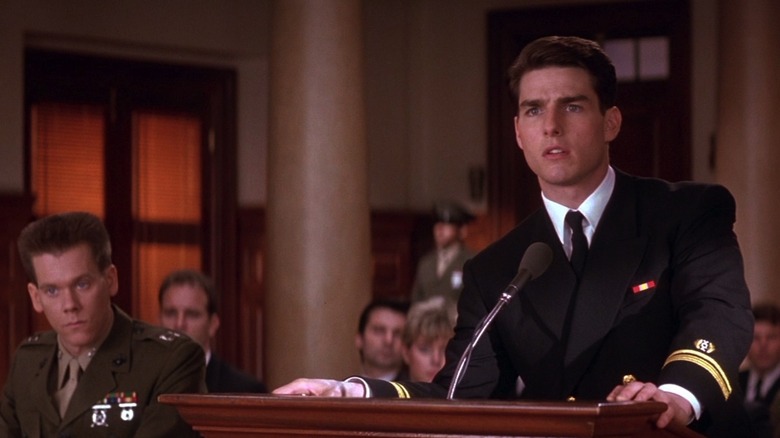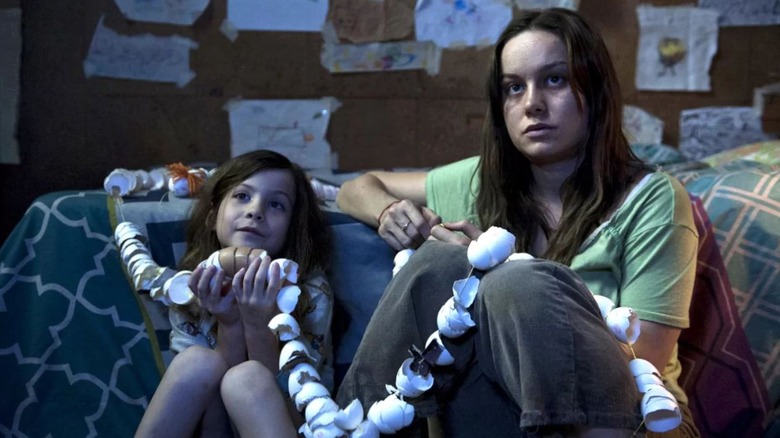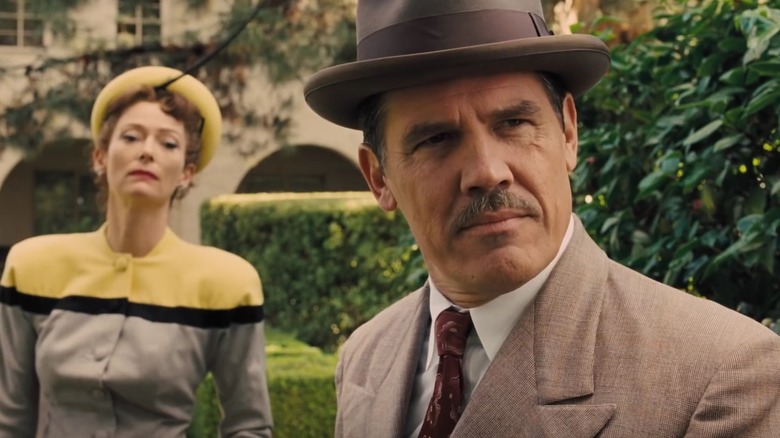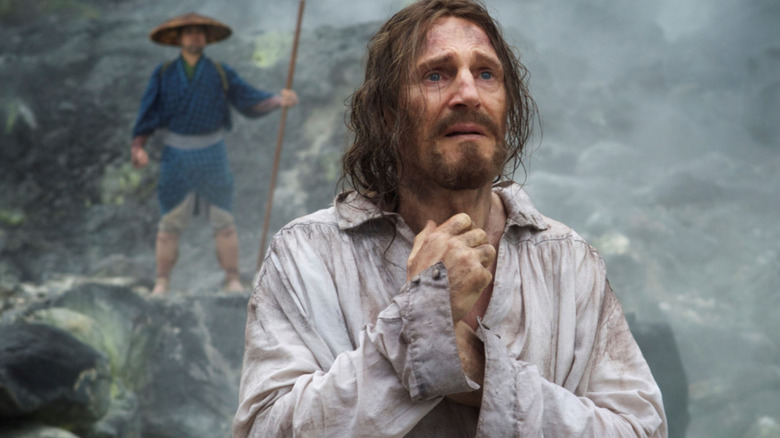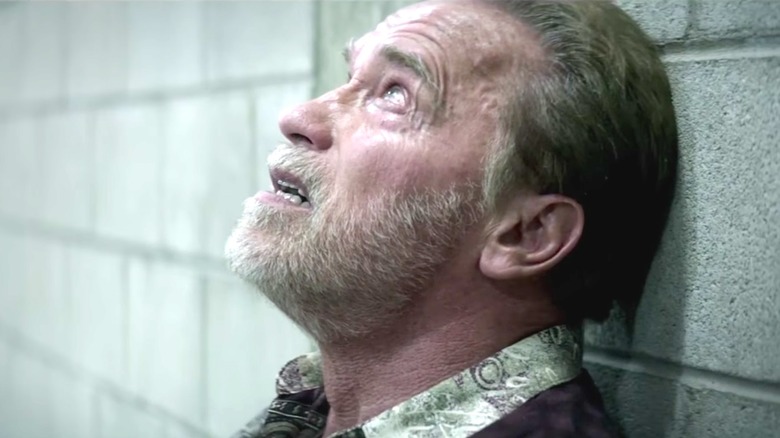Movies You Didn't Know Were Inspired By Dark True Stories
From legal thrillers to period pieces, cinema is full of movies that draw inspiration from actual events. Of course, that means quite a few films have been influenced by some pretty upsetting incidents. After all, life can be bleak, grim, and downright scary, and as it turns out, some of your favorite movies were actually inspired by dark true stories.
Rear Window (1954)
Everyone knows that Psycho was loosely based on infamous American tailor Ed Gein, but the 1960 slasher wasn't the only Alfred Hitchcock movie inspired by true events. In an interview with director Francois Truffaut, the Master of Suspense explained that his voyeuristic masterpiece, Rear Window, was influenced by two murders that sent shockwaves across Great Britain.
The first murder occurred in 1910, when Dr. Hawley Crippen claimed his wife had left England for the US. Naturally, Crippen's neighbors were suspicious when the doctor's girlfriend suddenly moved in, and they grew even more concerned when she started wearing his wife's jewelry.
This little twist inspired a moment in Rear Window when Jimmy Stewart's character realizes his neighbor probably wouldn't have gone on vacation without taking her wedding ring along, a fact that makes him suspect her husband (Raymond Burr) of foul play. But as for Dr. Crippen, he tried to flee the country, but thanks to the brand new invention of radio, he didn't get very far as the ship's captain recognized him and alerted the authorities. But why did he try to run? Probably because the police found a bunch of body parts in his basement.
The second crime that influenced Rear Window occurred in 1924 courtesy of Patrick Mahon, who was cheating on his wife with a co-worker named Emily Kaye. However, Kaye was pregnant and wanted more out of their relationship, so Mahon did the reasonable thing by murdering her in a beachside bungalow, dismembering her corpse, and boiling the body away in a big pot.
Of course, everything fell apart when a family friend discovered women's clothing and a bloody knife in Mahon's luggage, and when the cops showed up at his seaside cabin, they found a few bags full of human flesh. Evidently, Mahon hadn't finished tidying up just yet, and thanks to his laziness, the man was soon swinging from the gallows. Sure, it's a pretty grisly story, but on the plus side, the case inspired cops to start wearing rubber gloves when cleaning crime scenes, and it gave Hitchcock the idea of a killer disposing of a body piece by piece.
The Night of the Hunter (1955)
One of the most nightmarish movies ever made, The Night of the Hunter stars Billy Chapin and Sally Jane Bruce as John and Pearl, little kids with a horrible secret. Their dad is a convicted bank robber, but before he was sent to prison, he told the two where he'd stashed his ill-gotten gains.
Unfortunately, they aren't the only ones who know about the money. The Rev. Harry Powell (Robert Mitchum), a woman-hating serial killer with "love" and "hate" tattooed across his knuckles, is looking for the cash, so he marries the kids' mom (Shelley Winters) before dumping her in the river. The preacher then turns on the children, threatening them to reveal the location of the loot and setting off a game of cat-and-mouse, complete with Bible verses and switchblades.
Directed by Charles Laughton, the movie was based on a novel by Davis Grubb, who was inspired by the real-life case of Harry Powers. A Depression-era conman from West Virginia, Powers would place ads with matrimonial bureaus and wait for desperate women to send him letters. He would then pen flowery notes, building himself up as a hard-working, God-worshiping entrepreneur in need of a wife. Of course, once he gained their trust, Powers would strangle the women to death and try to steal their savings.
Powers killed two women and three kids (the children of one of his victims) before the cops finally caught up with the "Bluebeard of Clarksburg." When the public learned about his crimes, thousands of angry West Virginians formed a lynch mob—just like in the movie—and stormed the jail. The police, however, managed to spirit him away, and justice took its course in 1932, when Powers went out on one last date...with the hangman.
A Nighmare on Elm Street (1984)
With his red-and-green sweater and iconic claw glove, Freddy Krueger slashed his way into the hearts of horror fans everywhere with A Nightmare on Elm Street. Over the course of the ever-growing franchise, Krueger has invaded the dreams of countless teens, dropping clever quips and bloody bodies with equal abandon. But while this supernatural serial killer was a product of Wes Craven's twisted imagination, the writer-director was actually inspired by several real-life incidents.
In a 2008 interview with Cinefantastique Online, Craven said that as a young boy, he woke up one day to find a drunken man outside his window. The bum was just staring at Craven, and understandably, the kid was totally freaked out. Things only got worse when the man "started walking almost half-backwards" toward the entrance of Craven's apartment, all the while watching the terrified boy. Fortunately, when Craven's brother went to investigate (with baseball bat in hand), the man had disappeared. "He was drunk," Craven said of the guy outside his window, "having a good time. But the idea of an adult who was frightening and enjoyed terrifying a child was the origin of Freddy."
But what really kicked Elm Street into high gear was a series of mysterious deaths during the '70s and '80s. Cambodian refugees were inexplicably dying in their sleep, and this was happening so often that the Center for Disease Control began digging into the cause of "Asian Death Syndrome." Craven was particularly affected by the story of a 21-year-old man who refused to sleep for a whole week, afraid of what might happen if he slipped into dreamland. The poor guy was constantly drinking coffee, and when his family gave him sleeping pills, he faked taking them and then stashed them in a hiding spot.
Sadly, when the man finally fell asleep, he inexplicably passed away. Today, this phenomenon is known as SUNDS (sudden unexpected nocturnal death syndrome), and according to LiveScience, it's a genetic disease where "the body fails to properly coordinate the electrical signals that cause the heart to beat," and it often affects young Asian men when they're sleeping. Dying suddenly in your bed is an especially creepy way to die, and with the image of that drunken old man lurking in his memory, Craven combined the two events, created a monster, and named the killer after his childhood bully...Fred Krueger.
River's Edge (1987)
A little-seen movie from 1987, River's Edge was a controversial and critically-acclaimed film starring Keanu Reeves, Crispin Glover, Ione Skye, and Dennis Hopper. The drama starts when a psychopathic teenager (Daniel Roebuck) murders his girlfriend and dumps her body near the edge of a river. The guy starts bragging to his friends about his dirty deed, but instead of telling the cops, the local teens decide to check out the body, keeping the killing a secret and treating the murdered girl like some sort of carnival attraction.
In real life, the story played out almost exactly the same way. A 16-year-old named Anthony Jacques Broussard brutally raped and killed 14-year-old Marcy Renee Conrad, and then tossed her into a ravine in Milpitas, California. Similar to the film, Broussard told his buddies about the crime, and soon, the local youths were all gathering around Conrad's corpse. (One kid even tried to help Broussard hide the body.) Believe it or not, this went on for two whole days before the police discovered what was going on, and even though he was just 16, the killer was tossed behind bars for life.
A Few Good Men (1992)
Think you can handle the truth about A Few Good Men? Directed by Rob Reiner, this legal thriller was inspired by Aaron Sorkin's Broadway play, and the story follows a Navy lawyer (Tom Cruise) who defends two Marines accused of killing a comrade during a "Code Red." Cruise argues the murder was accidental and that the defendants were following orders from the higher-ups. As a result, the Marines are dishonorably discharged but manage to beat the murder rap.
In real life, the story that inspired Sorkin centered on a Marine named William Alvarado (William Santiago in the film). Alvarado served at the Navy installation on Guantanamo Bay, and his job was to stand guard at the edge of the base, keeping an eye on Cuban soldiers on the other side of the perimeter. Unfortunately for Alvarado, he wasn't very popular in his platoon, as his fellow Marines believed he'd ratted on a guard who'd fired his weapon into Cuban territory.
As a result, ten guys blindfolded, gagged, and beat Alvarado, and during the assault, he lost consciousness after his lungs started filling up with liquid. Unlike the character in the movie, Alvarado survived the assault, and seven of the men involved accepted dishonorable discharges. However, the three remaining Marines took their chances in court, where they claimed they were just obeying their commanding officers. The trio actually got off pretty light, avoiding serious penalties, and at least one of the defendants—David Cox—was honorably discharged after finishing his time in the Corps.
Naturally, Cox didn't care for A Few Good Men, and he planned on joining a lawsuit against production company Castle Rock Entertainment. However, before anything could come of the case, Cox was mysteriously murdered. To this day, nobody knows who did the killing, so there's a perfect plot ready to go if Aaron Sorkin wants to write A Few Better Men.
Backcountry (2015)
Unless you're Davy Crockett, the woods can be a pretty scary place. You might run into evil trees, horny hillbillies, or—more realistically—a creature craving human flesh. That's exactly what happens in Adam MacDonald's Backcountry, a Canadian thriller starring Jeff Roop and Missy Peregrym as a backpacking couple who lose their way in a never-ending forest. As they wander into the wilderness, they encounter a hungry bear, and well, let's just say things don't end well.
Tragically, Backcountry was inspired by an actual bear attack, one that writer-director Adam MacDonald came across while researching for the film. The actual incident occurred in 2005, when Mark Jordan and Jacqueline Perry decided to spend their fourth wedding anniversary in the woods of northern Ontario. During their trip, a starving black bear went after Perry, but Jordan managed to fight the beast off. He punched the animal in the face and stabbed it with a Swiss Army knife, driving the bear back into the woods.
Thinking fast, Jordan put his wife in a kayak and began searching for help, but sadly, Perry passed away before they could reach civilization. Needless to say, Jordan was devastated, and he also needed 300 stitches to take care of his own wounds. However, while it couldn't make up for his pain, the man was awarded the Star of Courage in 2007, Canada's second highest award for bravery.
Room (2015)
After wowing critics with her performance in Short Term 12, Brie Larson won an Oscar for Lenny Abrahamson's Room, a heartbreaking film about the love between a mother and her kid. In the film, Larson plays a young woman named Joy who's been abducted, imprisoned, and serially raped by a man known only as "Old Nick." As a result, she's given birth to a son named Jack (the amazing Jacob Tremblay), and together, the two live in a one-room shed, cut off from the rest of the world until Jack finally escapes and brings the police.
Room was based on a novel by author Emma Donoghue, but as it turns out, the concept for her book was "triggered" by the real-life case of Elisabeth Fritzl, an Austrian woman who was locked in a cellar at age 18. Even worse, her captor was her own dad, Josef Fritzl. This monster kept Elisabeth imprisoned for 24 years, and during that time, she gave birth to seven children. One died shortly after birth, three lived in the basement with their mother, and three were raised by Fritzl and his wife Rosemarie.
Shockingly, Elisabeth's mom had no idea what was going on. Fritzl had convinced her that their daughter had run away. As for the kids, Fritzl admitted they were Elisabeth's, but he claimed he'd found them on the lawn, abandoned by their mom. However, the horror show ended when Elisabeth's oldest child—19-year-old Kerstin, who'd spent her entire life in the dungeon—became gravely ill. Fritzl was forced to take her to the hospital, and soon after that, the police put the puzzle pieces together. The 42-year-old Elisabeth was finally freed and reunited with her children, and as for Fritzl, he was—appropriately enough—put away for life.
Hail, Caesar! (2016)
Written and directed by the Coen Brothers, Hail, Caesar! pulls double duty as a satirical love letter to old Hollywood, and while it's not a true story, it draws inspiration from real-life characters. For example, Scarlett Johansson is basically playing swimming star Esther Williams, and Channing Tatum is an obvious nod to Gene Kelly. But the biggest connection between Hail, Caesar! and Hollywood history is Josh Brolin as Eddie Mannix, a character based on a guy named—yep—Eddie Mannix.
Just like the onscreen Eddie, the actual Mannix was a movie studio fixer, a dude who covered up scandals for MGM. He helped pregnant actresses secretly obtain abortions, and he made sure that car wrecks involving A-list stars were kept out of the papers. However, while the fictional Mannix comes off as a likeable guy, the real Mannix was downright despicable. It's believed he violently beat his mistress, sending her to the hospital multiple times, and when she tried to sue him, Mannix had the cops chase her out of Hollywood.
It's said that Mannix read every telegram sent from the MGM lot so he could keep tabs on all of the stars, and he allegedly had his gangster friends frighten actors who wouldn't toe the line. It's believed he played a part in getting Judy Garland hooked on drugs, and some suspect he was involved in the death of George Reeves, TV's Superman.
Perhaps worst of all, Mannix was instrumental in covering up the rape of Patricia Douglas, a wannabe actress assaulted by MGM salesman David Ross. When Douglas tried to go public with her story, Mannix did his best to discredit her, hiring private eyes to look into her past. When that didn't work, he convinced other actresses to swear under oath that Douglas was an alcoholic (she wasn't), thus casting doubt on her character and her story. Thanks to Mannix's tactics, Douglas was totally discredited, and years later, the fixer supposedly joked, "We had her killed."
Silence (2016)
Based on the novel by Shusaku Endo, Martin Scorsese's Silence is one of the most devastating movies in recent memory. This 17th-century period piece follows two Jesuits, Father Rodrigues (Andrew Garfield) and Father Garupe (Adam Driver), who travel to Japan in hopes of rescuing their mentor, Father Ferreira (Liam Neeson). Rodrigues has learned that Ferreira was tortured into renouncing his faith, and during their quest, the priests find themselves in the same exact scenario when they're arrested by an official (Issey Ogata) tasked with wiping out Christianity in Japan.
Even though Silence is a work of fiction, it draws a lot of inspiration from an actual case from 1633, when a Portuguese priest named Cristovao Ferreira was arrested for his missionary work. Similar to what happens in the film, Ferreira was hung upside down and partially buried in a ditch. Eventually, the priest apostatized, exchanged his Christianity for Shinto, and then went to work for the Japanese government, writing pamphlets against the Church and interrogating Catholic missionaries.
Shortly after Ferreira's conversion, a group of priests arrived in Japan hoping to save his soul. One of these Jesuits—an Italian named Giuseppe Chiara—served as the basis for Andrew Garfield's character. Unfortunately for Chiara, he wound up in the same situation as Ferreira, and after recanting his faith, Chiara adopted a Japanese name, got married, and dedicated himself to translating scientific tomes before passing away in 1685.
Aftermath (2017)
Directed by Elliott Lester, Aftermath finds Arnold Schwarzenegger abandoning the punny one-liners and, instead, flexing his dramatic muscles. The superstar plays a construction worker named Roman Melnyk who loses his wife and daughter in a tragic plane crash. Crushed by the loss, Melnyk decides to get revenge on the air traffic controller (Scoot McNairy) he blames for his family's death, and after tracking the man down—spoilers ahoy—Melnyk stabs him to death.
Sadly, Roman Melnyk is based on a Russian man named Vitaly Kaloyev. In 2002, Kaloyev's wife and two kids were flying from Moscow to Barcelona when their plane crashed into an oncoming airliner. As a result, 71 people died, 45 of whom were children. Grief stricken, Kaloyev rushed to the crash site where he personally discovered his daughter's corpse.
Initially, some suspected that a Swiss air traffic controller named Peter Nielsen was to blame, although he was eventually cleared of any negligence. Kaloyev wasn't convinced, though, and the situation only got worse when Skyguide—the company Nielsen worked for—offered Kaloyev money so he wouldn't go after them in the courts. Infuriated, Kaloyev tracked Nielsen down, and after showing up at the guy's house, the grieving father stabbed Nielsen to death.
After the murder, Kaloyev was sentenced to eight years behind bars, but thanks to some political maneuvering from the Russian government, he was released after two. However, the killing hasn't helped Kaloyev get past his loss. As he put it, "Killing [Nielsen] didn't make me feel any better."
